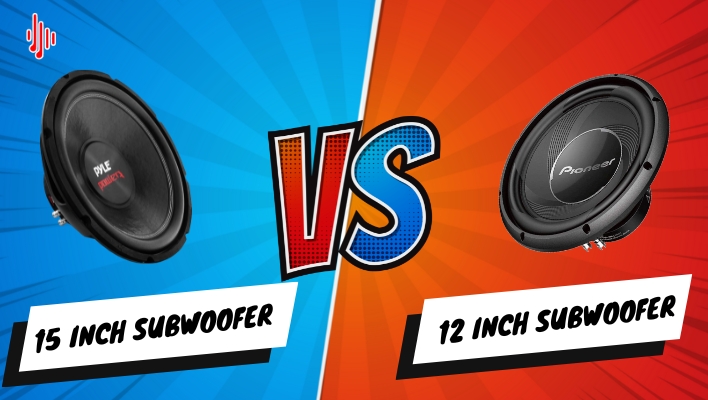In the world of home theater, subwoofers are crucial to creating an immersive experience. You can have the largest and most impressive speakers, but they won’t sound nearly as good as they could until you get a subwoofer in there to supply that low end. Whether you’re building a brand-new home theater from scratch or just looking to upgrade your existing system, selecting the best subwoofer for your space and needs is essential for getting the best sound possible.
In fact, it’s arguably even more important than choosing your main speakers since the role of subwoofers is to handle only that low-end frequency range below 200 Hz. When buying a new sub, deciding what size to get is a significant factor. There are many different options, but two of the most common are 12-inch and 15-inch subwoofers. Which one is better?
What’s The Difference Between 12-Inch and 15-Inch Subwoofers?
Here we discuss the major differences between 12-inch and 15-inch subwoofers.
1. Size
The main difference in a 12 vs 15-inch subwoofer comparison is their size. As the name suggests, a 12-inch subwoofer is smaller than a 15-inch subwoofer. This means that a 12-inch subwoofer will be more compact and easier to install in a smaller space, such as in a car or a small home theater system.
In terms of performance, a larger subwoofer, like a 15-inch model, will generally produce deeper and more powerful bass than a smaller 12-inch subwoofer. This is because a larger subwoofer has a longer cone, which allows it to move more air and produce deeper bass notes. However, a 12-inch subwoofer can still provide good bass performance in a smaller room or when paired with a high-powered amplifier.

2. Sound Quality
The size of a subwoofer does not necessarily determine its sound quality. Sound quality depends on factors such as the design and construction of the subwoofer, the materials used, and the quality of the amplifier and other components in the system. A well-designed and properly installed 12-inch subwoofer can produce high-quality sound, just like a 15-inch model.
3. Sound Characteristics
The size of a subwoofer can affect its sound characteristics, such as the type of bass it produces and its ability to reproduce low-frequency sounds. As mentioned earlier, a larger subwoofer, like a 15-inch model, will generally produce deeper and more powerful bass than a smaller 12-inch subwoofer. This is because a larger subwoofer has a longer cone, which allows it to move more air and produce lower-frequency sounds.
However, the sound characteristics of a subwoofer also depend on its design and construction. For example, some subwoofers are designed to produce a tight and punchy bass sound. In contrast, others are designed for more powerful and “boomy” bass. Generally, it’s best to listen to a subwoofer in person to determine its sound characteristics and whether it will suit your preferences.
4. Components and Materials
A 12-inch subwoofer and a 15-inch subwoofer can both be made with high-quality components and materials. The key difference is that a 15-inch model will require larger and more powerful components, such as a larger magnet and voice coil, to produce deep bass.
When it comes to materials, the type of cone, surround, and other materials used in a subwoofer can affect its sound quality and performance. For example, a subwoofer with a cone made of rigid and lightweight materials like carbon fiber or Kevlar can produce faster and more accurate bass. The type of surround and suspension materials can also affect a subwoofer’s performance, as these materials help control the cone’s movement and produce a smooth and linear response.
5. Required Power Coverage
15-inch subwoofers generally require more power than smaller 12-inch subwoofers. This is because larger subwoofers have longer cones that need more energy to move and produce deep bass.
However, the amount of power a subwoofer requires also depends on its design and construction, the materials used, and the type of bass it produces. Some subwoofers are designed to be highly efficient and can produce loud bass with less power. In comparison, others may require more power to achieve the same volume. It’s important to consider the power handling capabilities of a subwoofer and match it with an appropriate amplifier to ensure that it performs well and doesn’t overheat or become damaged.
6. Price
In general, 15-inch models are more expensive than smaller 12-inch models. This is because larger subwoofers require more materials and larger components, which adds to the overall cost of the subwoofer. Additionally, larger subwoofers are often more powerful and capable of producing deeper bass, which can also add to their cost.
However, the price of a subwoofer also depends on factors such as its brand, design, and overall quality. Some 12-inch subwoofers can be expensive, while others may be more affordable. It’s best to shop around and compare different subwoofers to find one that fits your budget and meets your performance needs.
Which is the Best Subwoofer Size Overall?
There is no one-size-fits-all answer to which subwoofer size is best. The best subwoofer size for you will depend on your individual needs and preferences. If you have a small space, such as a car or a small home theater system, a 12-inch subwoofer may be a good choice because it will be more compact and easier to install. On the other hand, if you have a larger space and want deep and powerful bass, a 15-inch subwoofer may be a better choice.
Ultimately, the best way to determine the best subwoofer size for you is to listen to different subwoofers in person and compare their sound quality and performance. This will allow you to make an informed decision and choose a subwoofer that suits your needs and preferences.
